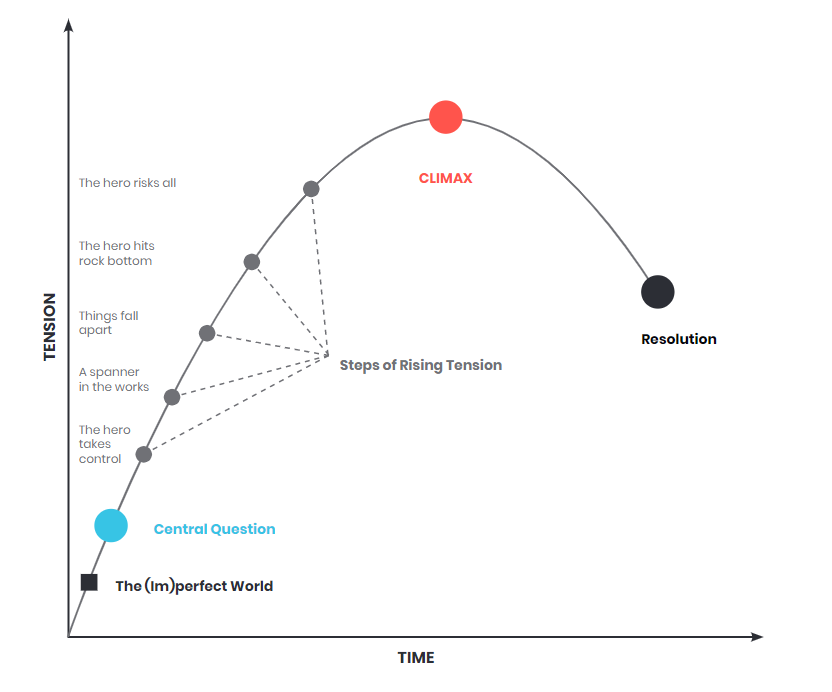There are eight essential elements that create a good story. Although it may seem like a cheesy, Hollywood formula, this structure can easily be applied to your narratives and stories.
1. Tension and time
"Tension" in storytelling is the feeling the audience faces of trying to figure out what happens next. A story requires the tension to build up, so that our desire to find a solution to the problem posed at the beginning of the story is getting greater and greater as the story progresses. As humans, we are naturally problem-solving creatures; we want to be confronted with a problem we want to solve, we make an assumption about how the problem will be solved, and then we check if our assumption is correct. This tension must be rising as the story develops. We do not like stories that go no-where or stories that have very low tension level. We simply find them boring.
The "time" from the headline relates to the "story time". A story, as it is told, may be happening in a few minutes, or it may span over decades. What is important here, is that specific period of story time is chosen for maximum tension. The story can be told chronologically, or it can be more suspenseful and use flashbacks.
2. An (im)perfect world
At the beginning of the story, the characters usually live in a perfect world. Even if the world we enter into as the audience is not a perfect one, for the people in the story it is. This world ends for them, when the central question is posed.
3. The Central Question
The central question is a Yes-or-No question. Once the perfect world has been introduced, we need to be confronted by a problem or quest that the protagonist needs to solve. This question will draw the audience's attention to try and find the answer to it throughout the story. As a rule, the answer will be given in the climax of the story. Until the climax arrives, the viewers feel the urge to constantly ask themselves: what could happen next?
4. Rising Tension
This comes from the twists and turns and challenges that the protagonists face. The tension rises, as they try to succeed and fail, and try again afterwards, until they eventually do triumph. Without any obstacles in their way (the steps of rising tension) we, as audience, may feel "cheated" and disengage from the story.
5. Climax
The climax is the long-awaited answer to the central question. It is the "aha!" moment in the story, in which the main character is rewarded or punished for adopting new types of behaviour. It is a crucial moment of irreversible change. In this part of the story we learn the answer to the question we have been waiting for the whole time.
6. Resolution
Resolution is the consequence of the story. Usually the protagonist is rewarded and the enemy is being punished. The order is restored, and a new perfect world is established. The most common ending in fiction is: "and they lived happily ever after...", to conclude the events happening in the world of the narrative. This is created to give the audience a feeling of completion. The resolution also shows the reward or fate the main character has earned, which induces a positive or negative set of emotions in the audience.
7. Symbol(s)
The meaning of a given symbol needs to change from the beginning to the end of the story. For example, in "The Lord Of The Rings", the "One Ring" is a symbol of "evil, deception and greed", but with time it also becomes a symbol of Frodo's sacrifice for others. A symbol is not a structural component of a story. It is rather a storytelling device. A symbol in a story is more than a symbol in a language. A story symbol has specific requirements and is defined differently than something that is "symbolic". The symbol used in a story should be culturally understood.
8. Universal truth
Universal truth is the moral premise of the story, as well as its deeper meaning. Something we learn as an audience. It is usually based on an emotional shift. The universal truth is the deeper meaning of the story; it is what the audience is left with at the conclusion and it is usually a strong argument and an attitudinal lesson.
You can see in the graph below, the visualization of the 8 essential elements of a story, called "the "Arc of Tension":

So, this, in a nutshell, is the theory behind building gripping stories. Are you ready to get some practice?
Take another look at the ‘arc of tension’ above and start analyzing one of your favorite stories by looking for these milestone elements in it. You can also watch this video and try and pinpoint all of the elements there.
And then, after this brisk warm-up, try to find these 8 key elements in the stories you are sharing with your audience!
If you want to learn more about how to apply these elements in your stories and campaigns, join our free online course in Building Positive Narratives and get more tools to make your stories even more powerful!
